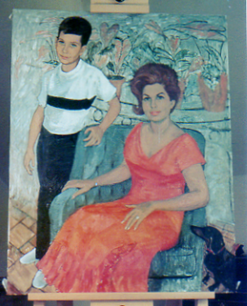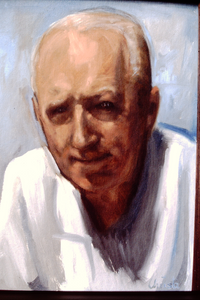
SELECTED WORK
By Decade
Below are varied selections of Christa's work, grouped by decade to show her range of subject matter, changing style, and use of media. Because most of her work was not cataloged during her lifetime, but posthumously, relying on memory, subject matter, dates on select pieces and her notes and slides of her artwork, some pieces may be misattributed by date.
With over a thousand known, and documented, and hundreds of unknown pieces, the images below provide an overview of the range of Christa's output.
THE 1940S
The decade starts with Christa finishing her schooling and setting up her own studio in Kronberg. She goes on to forge connections in Frankfurt's arts scene, making contacts, and getting commissions.
As Germany struggled to rebuild after the war, Christa took a teaching position in 1945 at the Master School in Offenbach, the forerunner of the Hessen State University of Art and Design. She exhibited in Frankfurt and Heidelberg and continued commissions and portraits including Freiherr von Berlichingen and family, Prince Hohenlohe, Professor Giese, the actor Hermann Schomberg (as Goetz von Berlichingen), and others.

THE 1950S
By 1951, Christa has arrived in Washington, DC, making contact with the city's social network and receiving requests for portraits from diplomats and society leaders in the city.
Toward the end of the decade, Christa's interest in abstract art and media other than canvas and paint grows. She spends several years using what she called "swimming pool plastic" (acrylic resin) as a medium for abstracts, nature collages and creates one portrait, of her oldest daughter, in the new medium.

THE 1960S
There is continued interest in traditional portraits early in the decade and Christa has some commissions at the same time her interest in alternative media and subjects grows. She is experimenting more with acrylic paints and enamel and using various surfaces including masonite and board.
The oversize tight headshot-style portraits of the Georgetown Law Professors commissioned by Georgetown University Law School represent a step of her evolution. Created with paint and palette knife on large (3'x4') masonite sheets, the heads are four times life size. The portraits were deemed too extreme by the school and refused. This may have been a turning point in her career as her work over the next decade reflects a divergence from traditional portraits.

THE 1970S
There are few knownl portraits found among Christa's work from this decade. Her second husband has moved out and her children are about to graduate and leave home. She has begun taking and teaching classes at area universities and her work reflects an experimentation with styles and subject matter using studio models for much of her figure work.

THE 1980S
By the start of the decade, Christa has settled in her townhouse with studio in Southwest Washington. She has a modest real estate career and she makes efforts to restart her career as a portrait painter. Unwilling to hire an agent to represent her, she attempts to engage clients on her own with mixed results.
After a few years, she concedes that the art market has changed. Around 1984, she discovers San Miguel de Allende and the financial benefit of living part-time as an expat while renting her house in Washington. The bright colors of Mexico begin to reflect in her artwork. Macular Degeneration begins to affect her eyesight although she is still driven to create and her output includes hundreds of prints, sketches, and paintings documented through 1994.

























































































































